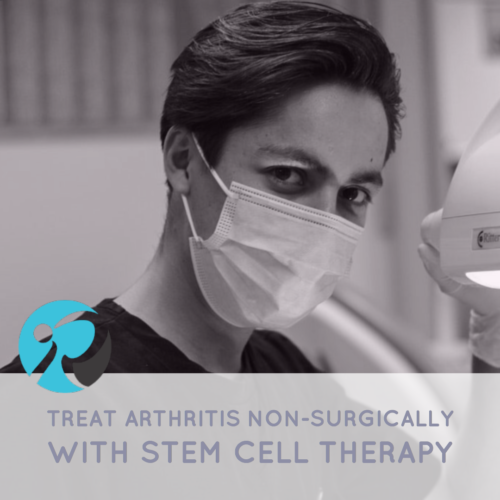
Avoid Joint Replacement With Stem Cell Therapy
Joint replacements are on the rise. They have increased so much that, in the last ten years, knee replacements have more than doubled and hip replacements more than tripled. i As life expectancy increases, this number will continue to go up.
Arthritis is the most common cause of chronic knee and hip pain, and this condition eventually leads to joint replacement.
The goal of traditional therapies is to decrease pain and improve function. Treatments, such as weight loss, exercise, physiotherapy, bracing, and orthotics, may help temporarily. But they are unfortunately unable to actually repair the joint instability or the source of pain.
The increased mechanical stress caused by injury to the ligaments, meniscus, labrum, and other joint structures, changes the way the joint functions. And that makes the joint unstable and even more susceptible to further soft tissue injury.
When left unrepaired, the long-lasting effect of continual joint instability is arthritis. Again, many conventional treatments do not last in providing pain relief because they fail to repair the instability. And they are also unable to prevent the eventual joint replacement. The road to arthritis, and the ensuing joint replacement, can only be remedied when the problem of joint instability is addressed.
NSAIDs (non-steroidal anti-inflammatory drugs) and corticosteroid injections are conservative, non-surgical therapies generally recommended initially for pain alleviation. And although steroid injections and NSAIDs have been shown to be effective in decreasing inflammation and pain short-term, they do not reverse the disease.
But they do inhibit the properties of healing. And that’s important to realize! For this reason, their use is cautioned in those who have joint injuries and arthritis. Interestingly, NSAIDs and corticosteroids have no beneficial effect on articular cartilage in arthritis. But instead, they accelerate the very disease for which they are most often used and prescribed. And they are a catalyst towards joint replacement.
It is interesting to point out that not long after doctors started injecting cortisone and other steroids into joints way back in the 1950s, reports of terrible joint diseases were already surfacing. And even back then, their intra-articular use was discouraged. Corticosteroid injections accelerate cartilage degeneration and joint destruction. Today, despite the dangers, cortisone use is widespread and has become the standard of care.
What about the popular use of hyaluronic acid injections for joint pain? Unfortunately, those who do find some pain relief from hyaluronic acid, generally only experience short-term results. The use of hyaluronic acid injections, like Synvisc, are frequently designed to delay the inevitable joint replacement. Even the seemingly harmless RICE (rest, ice, compression and elevation) protocol has been rescinded by its author due to its detrimental effect on healing.
An attempt to eliminate pain or a painful area by the arthroscopic shaving, cutting, or removal of tissue will only delay the pain for a few years until the remaining tissue becomes degenerated. And arthroscopy is a direct assault to the joint tissue. Arthroscopy, like the aforementioned treatments, may give some temporary relief of symptoms. But in the long-term, they will destabilize the joint and boost degeneration.
In the long-run, these surgeries can lead to even more surgeries and the eventual joint replacement. Athletes, who have surgical repair of injuries, like an ACL tear for example, have a low rate of return to sport, and a high rate of new injury. Surgery makes joint instability worse, not better.
Many surgeries such as labral repair and ACL reconstruction can provide remarkable short-term pain relief. However, the replacement material will not function long-term like the original. And ACL grafts and labral repairs with titanium tacks just do not have the same pliability as the original tissue. They cannot restore the joint back to normal. Eventually, they will cause problems.
The athlete or any joint pain patient must realize that with each procedure and each shaving or cutting of tissue, NSAID prescription, or corticosteroid injection, the risk of developing long-term arthritis and the eventual joint replacement is greatly increased. The key to keeping the joint strong is to stimulate the area to heal.
Regenerative Orthopedics stimulates healing and repairs the joint, rather than interfering with the normal healing process of the body. At OrthoRegen®, we use the Gold Standard in Regenerative Orthopedics. And we use Stem Cells from bone marrow and from fat. Both are excellent sources of Stem Cells.
PRP is then used to stimulate the growth of these Stem Cells and to repair the ligaments inside of the joint. The remaining Stem Cells that are left over are used along with Prolotherapy to treat the outside of the joint. That’s where there are many tendons and ligaments that control the joint and keep it stabilized. All of this is known as the Gold Standard in Stem Cell treatment, and is the only procedure we use at OrthoRegen®.
Stem Cell treatments, PRP and Prolotherapy, are all types of Regenerative Orthopedics. And they are all effective at stimulating the normal reparative mechanisms of the body, laying down new collagen, strengthening the tendons and ligaments, repairing the meniscus of the knee, hip and shoulder labrum, and boosting the cartilage growth.
These treatments work to reduce the chance of long-term arthritis and the eventual joint replacement. Stem Cells, along with PRP and Prolotherapy, offer hope to those suffering from various types of joint pain and trying to avoid joint replacement.
While surgery is necessary in a small percentage of patients, non-surgical regenerative therapies should be first-line, conservative treatments tried prior to surgery. The Gold Standard of Regenerative Orthopedics is effective even after surgery, when continued pain is experienced or for arthritis that was accelerated due to the surgery.
Keep in mind that once surgery is done it cannot be undone!
[i] Kim, S. Changes in surgical loads and economic burden of hip and knee replacements in the US: 1997–2004. Arthritis & Rheumatism,2008: 59: 481–488. doi:10.1002/art.23525